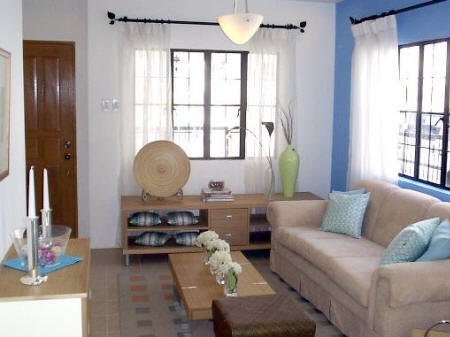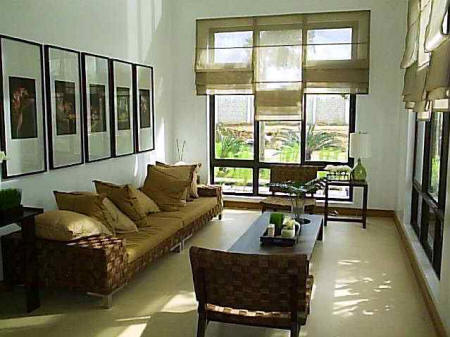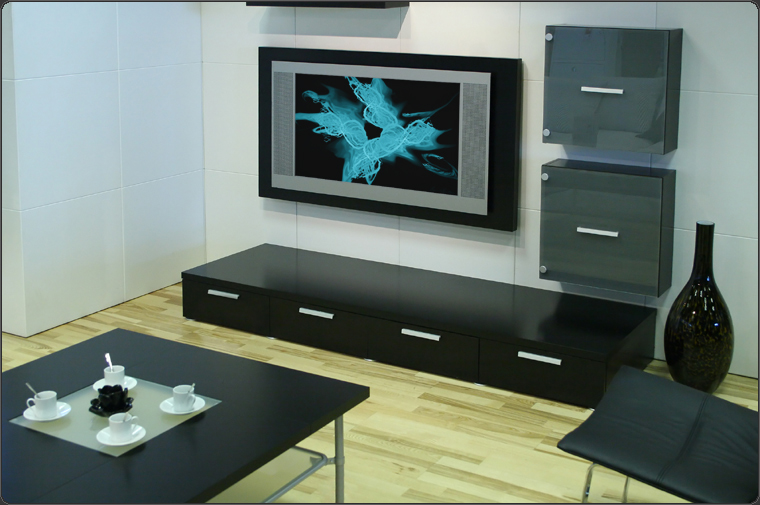feng shui living room principles are:
Create more Yin atmosphere if you want to bring more comfort, reduce arguments and tension at home. Use large cushy sofa, long rich curtains, soft natural materials and carpets…..in any combination of deep green, lighter brown and golden colors. Try to buy only furniture and sofa sets with nicely flowing round corners. Decorate with curvy items and round shapes. Bring in beautiful plants with large round shaped leaves, as according to feng shui, soil chi will help to calm fire chi in the room.
In feng shui, your windows represents your "eyes". They let you see the future. Therefore keep your windows clean and beautiful. Take advantage of all sorts of window coverings, such as wood blinds or shutters, soft shades or romantic valances. They will add soft shapes, natural materials and colors that enhance positive chi and make your family members and guests relax and enjoy time spent together.
There are suitable window treatments like custom pleated shades that helps create the ambiance that you want the room to project to your guests.
Avoid bright colors, especially red as it adds more argumentative chi as well. Use pieces of decorative fabric or plant to cover all pointy furniture or protruding wall corners to eliminate dangerous, sharp chi. Or, you can hang faceted crystal on 9” or 9 cm red ribbon in front of sharp wall corner.







Recent Posts
Best feng shui living room furniture layout
Create comfortable and friendly atmosphere by properly placing your furniture. Try to place seating furniture with its back to the wall and with the clear view of the main door. This lay out makes everybody feel safe and comfortable. Don’t block the view of your door with piece of heavy furniture or other items.
Arrange your furniture to allow chi flow around freely and easily. Try to visualize the flow of chi from your front door into and around your living room, and remove any obstacles.
Nice preferable round table further encourages communication and understanding as it enhances smooth flow of chi.







Fireplace and Living Room feng shui
Fireplace in your living room helps to create feeling of warmth and comfort but can also draw valuable chi out through the chimney. To prevent that, you can hang nice round mirror on your fireplace, which will reflect chi back into your room.
You can place plants around your fireplace to lower the heat and energy that come out. Soil in this case represented by plant stabilizes fire and heat. However, avoid any plants with wooden part as wood feeds the fire and you would create even more unwanted heat and energy.









Furniture
Before selecting the furniture make sure what style you want. It can be Traditional, Contemporary, Victorian, European and mix of two. There is no hard and fast rule of sticking to one style as you can use your own creativity to create the style of your own. Also decide the color scheme in advance as your whole efforts will go waste at the end if there is a big mismatch. Once you have decided that shop for the furniture.
Color
The color scheme will be according to the furniture that you have selected. You can either have the same color but with different tone or you can have the contrasting color. Like in contemporary living room it is the contrast that rules the entire decor. On the other hand, in traditional style select the color as per the furniture color which is generally brown, beige and cream. Pick the wall color or color of wall paper according to the color of furniture, flooring and upholstery. Read living room decor ideas to know more.
Curtains
This is the most important part of furnishing. In this also comes the window treatments. Consider the wall and furniture color along with amount of Sunlight before buying curtains. Pick the bold color and floral pattern if you have picked the contemporary theme. You can go with the plain curtains with tassel and other accessories if the theme is traditional. The fabric of the curtain markedly affects the appearance. Pick light fabric if your room is small and has less light.
Accessories
There are many accessories in the market that can be used to enhance the overall look of the living room. These are throw pillows, rugs, carpets, wall hangings, paintings and other such products. Try to mix and match the different colors and designs to bring out the desired effect.
Living Room Tips
1. "Enlarge"a Picture. If the painting you'd like to put above your sofa is too small to make an impact, visually expand it by nailing a large frame of molding to the wall, then center the painting within that space.
2. Turn on the Power. "Lots of prints and whatnots deplete a room's power and sense of authority," says interior designer Nancy Braithwaite of Atlanta. Her advice: choose furniture for its form. "If the forms are exciting, the living room will be, too — especially if you overscale things a bit and cover all upholstered pieces with the same color solid fabric."
3. Consider a Mural. You can find wonderful historic reproduction murals in wallpaper books at your local home decorating center. Cover an entire wall or just a large picture-sized space of it framed with molding.
4. Divide and Conquer. To define the living and dining areas in a long room that has to accommodate both, install two waist-high shelf units (with doors) that project a few feet in from each side wall. The low units will keep air space open, add a needed horizontal element, and provide handy storage for both areas.
5. Add Visual Space. Painting woodwork and walls in the same light color will make a small room seem larger.
6. Create a Skyline. Don't keep all the elements at the same horizontal level. As Larchmont, New York, designer Libby Cameron suggests, "Arrange — or add — pieces to establish an interesting contrast of heights so that the eye goes up and down as it travels around the room."
7. Layer the Lights. Overhead spots (like track lighting) are great for highlighting special areas. But you also need table lamps for warm, eye-level light, as well as floor lamps (like torcheres) to complete the effect.
8. Maximize Mini-blinds. Add a rich sense of detail by centering a length of embroidered tape over each of the two front slat-connecting cords of your mini-blinds. Cut each tape length 1 inch longer than the length of blind when fully lowered. Iron cut edges under 1/4 inch, then use needle and thread to tack the back of the tape to the cord at the top and bottom of the blind, and at 12-inch intervals in between.
9. Make a Display Tray. To unify a collection of small items on a tabletop, cover the photo-backing cardboard of a wall-hung type picture frame with fabric that complements the display. Insert that in the frame, behind the picture glass, and arrange items on top.
10. Pay Attention to Detail. "When a room has a distinct architectural style, your furnishings should respect it, not fight against it," says Chicago interior designer Maxine Snider. "If there's no detailing to begin with, you can establish the spirit of a style by adding baseboards, window and wall casings, and other moldings suitable to it. These elements should give a sense of symmetry, of height and verticality (which you can achieve with shutters), and of scale."
11. Camouflage It. Hide an unsightly radiator behind a pretty four- or five-paneled standing screen to create a decorative element.
12. Vary the Shapes. When it comes to sofas, windows, rugs, and so on, rectangles rule. To balance them, try adding a few round throw pillows, an oval coffee table, a jar-shaped lamp, a round ottoman, a free-form sculpture, and/or flowers and plants.
13. Add a Faux Fireplace. A fireplace makes a perfect focal point, but if you don't have one, you can buy a quality portable version. Or create the same effect by placing an antique fireplace mantle-cum-frame against a wall. To make it look real, hide the exposed wall area within the frame with a painted fireboard.
14. Open it Up. If you've had it with clutter, simplify. Says interior designer Sally Sirkin Lewis of J. Robert Scott in Inglewood, California, "Pull up the carpeting, bleach the wood floors, and keep window treatments to the absolute minimum needed for privacy. And to really 'air' a room, arrange your furniture in a central island instead of lining it up against the wall. Then put a tree or a sculpture in that bare corner instead of a furniture piece."
15. Use the Door. Fasten a brass towel bar to a connecting door for displaying a folded quilt or a colorful crocheted throw.








